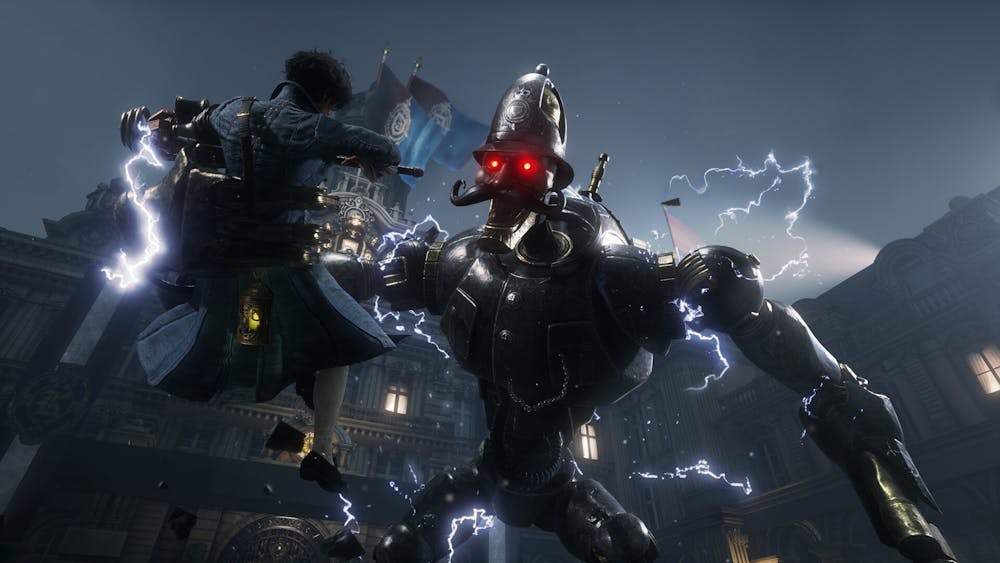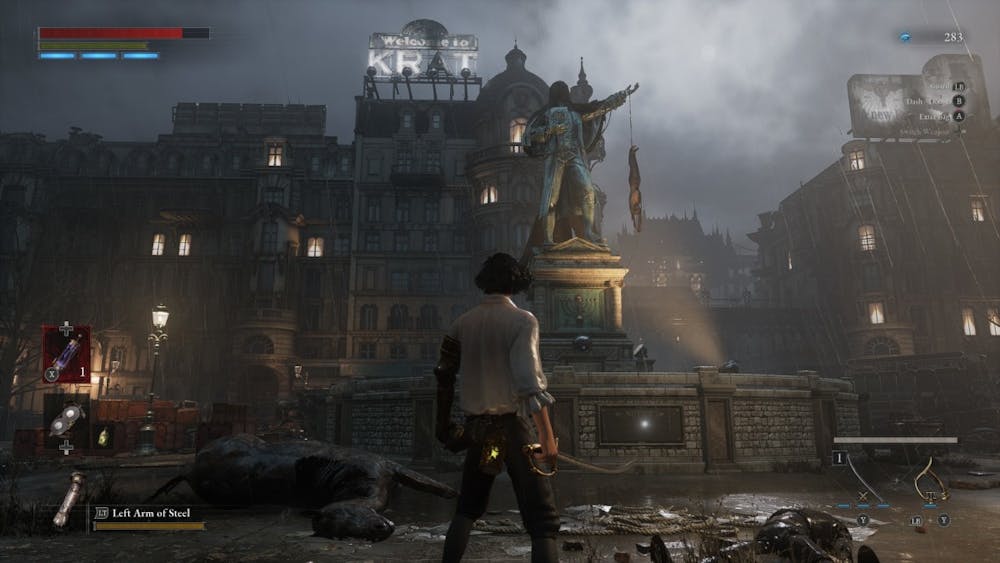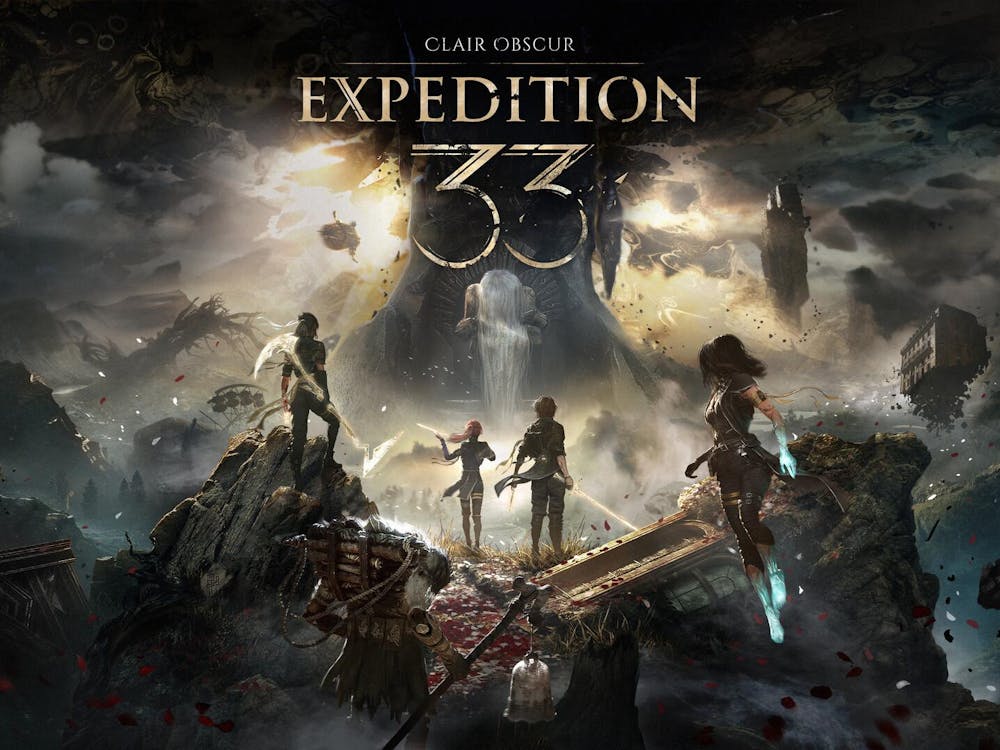The opinions and views expressed in this article are those of the author and do not reflect the opinion of Byte or Byte’s editorial board.
This review contains spoilers for the game Lies of P.
Reviewed on: PS5
Oftentimes, avid video game players keep an eye out for new releases that may fulfill their urges and fill the void between game releases. By far, the most hungry genre for games is the soulslike genre—a subgenre of action role-playing games with an emphasis on difficulty and environmental storytelling. However, though many games claiming to be of this genre are often announced and released, fans are often disappointed. This is due to the harsh challenge that comes from trying to emulate a game within this genre—either the game is too hard, too buggy, or is completely unbalanced.
It came as a surprise when, in May of 2021, Korean publisher Neowiz Games and developer Round8 announced their soulslike game based upon Carlo Collodi’s classic work The Adventures of Pinocchio. It wouldn’t be a stretch to say that people were skeptical. The studios were unknown and hadn’t produced a game similar to the genre, but this was quickly forgotten with the release of an attention-grabbing initial trailer. Honest excitement arose—but so did the ever-present fear; the game looked too good to be true. Eventually, a month before release, a demo for the game was released. The public played and expectation grew alongside further fear. It was excellent, but it was only the starting segments. What would the rest be like?
On September 19th, Lies of P finally went live—though for those, like me, who preordered, got to start playing three days early. Suffice to say, after 50 hours in my first playthrough on PS5, the truth was revealed.
No Star to Wish Upon—Fairy Tales Often Have a Dark Side
Like many games within the soulslike genre, there is a story to Lies of P. It is never fully set out in front of the players. Rather, they are expected to piece it together as they continue through the game, talking to NPCs and completing their stories. Unlike the vagaries that FromSoftware—the pioneers of the genre—flaunt with each game, Neowiz sought to make the story easier for players to understand while still allowing them to unravel bits and pieces as they go. They did this through cutscenes that would play at either the beginning or the end of each chapter, a key difference from many soulslikes.
As players enter the game for the first time, the story and hook presented is simple: playing as Pinocchio, you must find Geppetto (Anthony Howell) and determine the cause of the Puppet Frenzy and the Petrification Disease. As the game continues, more and more pieces unravel, telling a deeper, more fulfilling tale of betrayal, love, and reckless ambition. Information is given through cutscenes and dialogue with NPCs. At the same time, they are introduced to the stories of these interesting characters; Arlecchino (Joseph Balderrama), the King of Riddles; Venigni (Shai Matheson), a man using ego to escape repressed trauma; Polendina (Alex Waldmann), a puppet butler finding love; and so many more. Each story is brilliantly interwoven between the main story and the stories of other NPCs, andI would expect my nose to grow if I said I wasn’t on the verge of heartbreak by the end of several of their tales.

Taken from Steam
The story of Lies of P is one that builds upon the foundations of Carlo Collodi’s original tale and spins it into a clever, grimdark web. Neowiz clearly took the time to understand what made Collodi’s tale, pulling out the darker tones and moments of the story that many players may not even notice. The two most prominent examples of this would be the Black Rabbit Brotherhood and the brother-sister duo of Claudia the Fox (Chloe Claudel) and Lucio the Cat (Islam Bouakkaz).
In The Adventures of Pinocchio, a fox and cat convince Pinnochio to plant one of his gold coins, claiming it would become a tree that would make him rich. This obviously doesn’t work and was simply a ploy for them to profit off of Pinnochio’s naivety. In Lies of P, however, this is different. Several times, the players will meet the Fox and the Cat and they will be conniving and suspicious, making the players wary. Later on in Collodi’s story, the fox and cat deceive Pinocchio, steal his money, and hang him from a tree. While on his deathbed, four black rabbits appear carrying a coffin. Neowiz takes this concept and ramps it up into the Black Rabbit Brotherhood, a multi-enemy boss fight that players encounter twice through the game. When players meet the Brotherhood for the first time, the Eldest brother is carrying a coffin and slams it down before Pinocchio, revealing the word ‘Liar’ written inside.
Of course, that is to say that the story isn’t without its flaws. The biggest (and only) narrative issue is the treatment of main antagonist Simon Manus's (Matt Rippy) motivations and comeuppance, where he seeks to become a god only to wind up a disfigured creature. It is nothing new or inventive. In fact, it is so often played out to the point of cliche—just take a look at Resident Evil 5. However, the way the numerous stories are handled and woven together seamlessly puts a damper on the disappointment of that reveal and makes it extremely palatable.
Not Made of Wood—a Fluid, Real Show of Minimal Stumbling
A good story isn’t just the writing or the set up: it is the execution of the voice actors and the delivery of the world. To this end, Lies of P makes a spectacular show. When players first open up the game, they are met with a beautiful menu screen and countless settings to help them adapt to their comfortability, particularly the way the game runs and is viewed. Upon release, there are three graphical settings which players can choose from: default 30fps quality mode, 40fps for 120hz displays, and 60fps performance mode.
For my playthrough, I didn’t mess with these options, preferring to play with the default. That meant I was on 30fps the entire time. I never felt it as I played, though this could simply be a symptom of playing Bloodborne several times. Eventually, I found a rhythm and momentum, carving through puppets and carcasses like blades of grass beneath the blade of a lawnmower. Never once in my near 50 hours did the game stutter once. As I traversed and fell victim to enemies, I found myself immersed and transfixed by the myriad of locales that surrounded me.

Taken from VideogamesSI
Each one was grim, yet vibrant with its own life and complexities though felt desolate and wasted. Take, for example, the difference between the dark abandoned train station at the start of the game and the well lit, crumbling shambles of the St. Frangelico Cathedral, or the murky scrapyard of the Barren Swamp compared to the steampunk factory of Venigni Works. No matter where I was, there was something interesting and alluring to find, like the spectacle of a show unfolding before my eyes. In each area, beyond the sights and design of the locale itself, the variations in enemy type—but more specifically bosses—added to my wonder and amazement. From hulking parade puppets to terrifying police wardens, brotherhoods and sludge monsters, each boss was extremely unique in both looks and attack patterns. There are a few reskinned bosses to be wary of, as they have new attacks which increase variation and stand out from other attempts at this design style (asylum demon, looking at you).
Each area was only enhanced further by the NPCs I met in my journey. No matter who it was—Venigni the Merchant (Zachary Fall), Alidoro (Henry Lloyd-Hughes), Test Subject 826 (Connor Finch), etc—they were all voiced, and voiced well to top it all off. The same goes for all the other NPCs who often remained stagnant or in one location as well. Though, I found issues with only one voice actress: Sofia Jin, the voice of Eugenie. For the most part, her lines are well-written as the players go to her to upgrade weapons and craft a unique combination of your own. However, as her story unfolds, the voice acting falls. It wasn’t terrible, but it didn’t stick as well as it could have. I remember telling her the truth of the last family she had left. What should have been a tender, heartbreaking moment, wasn’t. She didn’t sound that upset or heartbroken about the news. Her voice acting just didn’t match up with the others or the writing provided to her character and didn’t allow me to connect as deeply as I should have with her story.
No Strings on Me—a Manikin of Idea and Look, Yet a Master of Itself
On top of mostly stellar performance and design, Lies of P also exceeds with its gameplay and unique ideas. However, because of this complex nature and new additions to the soulslike formula, there are far more hurdles to jump through. As an unknown company making their first game in a genre notorious for being difficult to design in, there are more slipups than in other titles. It becomes a balance of excellence and mediocrity.
Like any good fairytale, it is best to end on a high note. So, I want to discuss the issues and problems I faced with this incredible game. The first issue I truly took notice of was the timing of the parry and stagger windows. In the game, when the player staggers and parries an enemy enough, they can deal massive damage to them. However, it requires the player to build up a strong attack to do so. This is a big issue as, when the players are building up their attack, if they take any damage, the attack is canceled and they have to start again. By the time a window of opportunity to get the attack off has arrived, the opening has closed. This is extremely frustrating, especially with many of the later bosses (more on that in a bit). In addition, the animations for a lot of attacks—especially heavy attacks—are extremely long, making the game feel sluggish and exposing the player to several attacks. The annoyance of being hit and canceling an attack becomes grating and tedious the further the player gets. The third issue I faced was the build-up rate of the various afflictions within the many areas. As the players traverse, they are introduced to afflictions that drastically affect their play. This is nothing new to soulslike fans, but the rate at which such ones as Electric Shock, Decay, or Overheat Build-up saps the joy from fighting certain enemies. However, all of these afflictions pale in comparison to the terrible Disruption. When the player builds up enough Disruption, they instantly die, and unfortunately the latter half of the game is chock full of it. In fact, a majority of Chapter IX is spent traversing through areas in which crystals are littered about that inflict Disruption. Add in the numerous enemies the player has to face and you’ve signed a contract for a bad time. But it doesn’t end here…
Remember how I said I’d get back to the later bosses? Well, this is where my final issue with the gameplay of Lies of P comes in. In the back half of the game, players face enemies and bosses who are massive in size. Normally this would be a cause for celebration as it means larger hit boxes and slower attacks from the enemy. This, however, is not the case for Lies of P (though the hit boxes are larger) as a majority of the time the speed of the enemy or boss is seemingly improbable for a creature of their size. A notable and extremely annoying example of this is the final boss, Simon Manus. He is a huge opponent, yet moves with incredible speed that feels near impossible to counter, with the ability to attack rapidly and almost non-stop. Then, combine this with the annoying and excruciating fact that he can also deal Disruption to the player in his second phase and you have the makings of a hated boss fight. I dread to fight him again in New Game+.
Though it may seem like the bad may outweigh the good for this game, that simply isn’t true. In fact, there is more good and interesting about this game than I could even begin to go through. I want to cover some of it.
Lies of P may be a soulslike and takes its framework from that formula, but what it adds and changes makes all the difference in turning it from a mimicry to a tried and true masterpiece of its own, rivaling that of FromSoftware’s genre-defining Souls series (consisting of Demon's Souls, the Dark Souls series, and Bloodborne).
There are many things Lies of P adds to the soulslike formula that deserve far more attention. To start, there are the various collectibles of the game, such as records and cryptic vessels. While soulslike games are often known for having vast amounts of collectibles, they often have extremely mundane, almost forgetful purposes, like trophy hunting. Lies of P, on the other hand, uses collectibles to their full advantage. Records, which are collected through NPC stories or purchased from merchants in-game, serve as a soothing retreat from the chaos of the game as you can actually listen to the songs—yes, full length songs—in the central hub of Hotel Krat. But they go beyond just being a tool for music: listening to them increases Pinocchio’s humanity, helping progress the player towards one of the game’s endings. Cryptic vessels, however, serve as a way to reward players for hard work, giving them directions to a previous point in the game and providing them with items or Ergo.
Arguably, the two most notable differences and additions to the formula, comes in the form of the Legion Arm and the P-Organ. Both drastically affect how the game is played and creates a diversity in player type. To start, let’s begin with the P-Organ, the heart of Pinocchio. Soulslike games typically flaunt a “tree” of skills—which can increase things like health, attack power, stamina, etc—that players use to change the way their character moves and plays. While Lies of P does include such, it goes beyond it by including a typical skill tree in the P-Organ, which players can infuse with Quartz—a rare material in the game—to grant them different abilities. Moreover, playstyle is affected by the Legion Arm, which players can switch out and upgrade into different versions, going from flame, to an aegis, to a harpoon gun and more. Combined together, players have a variety of choices and styles of play to master and choose from as they progress through the game, adding an increased replayability factor alongside New Game+.
The gameplay of Lies of P, as I previously stated, felt smooth but weighty (in part because of the sluggish stagger time) with rapid, well chaining abilities or heaving, strength attacks. Even Pinocchio’s movement can be either quick and flitting, or leaden and plodding. Both contributed to different variations in playstyle. Everything had its purpose and the differences between weapons and playstyles that were to be had—combined with the addition of legion arms and P-Organ optimization—felt unique and provided routes for challenge or ease. You could focus on strength and mass strikes of damage, or speed and accumulating damage with elemental damage. It is a game balanced and optimized for all players of the genre, new and old. However, a rule between all soulslike games remains true in this game; never become greedy, patience is virtuous. In comparison with the founding fathers of the genre, Lies of P is accessible for all and is far more forgiving to the players. In FromSoftware’s games, when a player dies, their collected souls are left in that spot for them to collect. If they die again before collecting the souls, the souls are gone and are no longer able to be collected. In Lies of P, each time the player dies, only a fraction of their collected souls is taken away, giving greater incentive and kindness to them. In that same vein, I remember feeling disoriented and lost in where to go in several soulslike games. This, luckily, was not the case for Lies of P as the game is linear in the same way that Sekiro was; there is a clear, straightforward path, but there are also hidden secrets lying about.
Confronting the Lies, Finding the Truth
Like apprentices taking up the mantle of their predecessors before them, Neowiz and Round8 managed to craft a game so familiar to fans of its genre, yet so incredibly unique and beautiful. Through the use of foundations in classic literature, inspirations of real time periods and places, fantastic gameplay mechanics, and a meaningful story, Lies of P deserves a spot in the echelons of soulslike games. With the increasingly popular approval of the game—and a cheeky cliffhanger at the end of it—it seems likely that Neowiz and Round8 may find themselves competing against the fathers of soulslike games. It's a showdown between dark fantasy and dark fairytales.
In the end, Lies of P is a phenomenal rendition of Carlo Collodi’s original classic, utilizing dark storytelling and world design, passionate voice casting, and gameplay that feels both old and new at the same time. It is a soulslike through and through. One that every fan—old and new—of the genre should take the time to master. It’s more than mimicry, it is a real competitor—without strings—and it does not mess around.

Sources:
Neowiz, Goodreads, YouTube, VideogamesSI, LiesofP, FromSoftware, IMDb, IMDb, IMDb, IMDb, IMDb, IMDb, IMDb, ResidentEvil, Bloodborne, IMDb, IMDb, IMDb, IMDb, FromSoftware, FromSoftware, Sekirothegame
Photos:
Contact Aaron Picklesimer with comments at ampicklesimer@bsu.edu



















